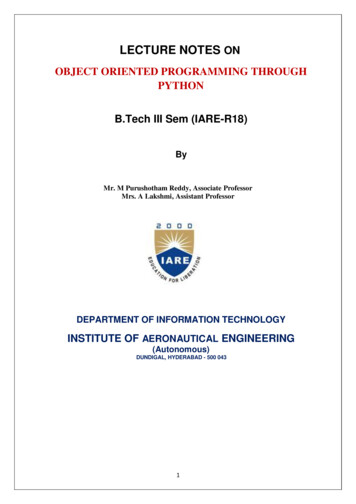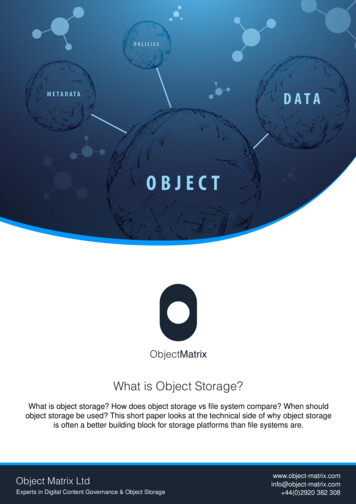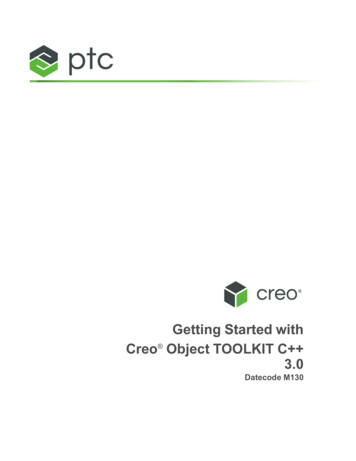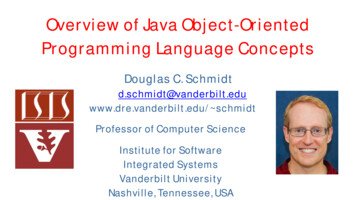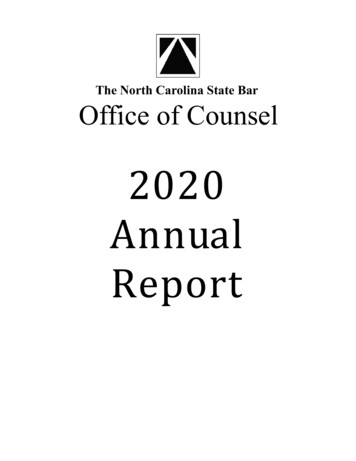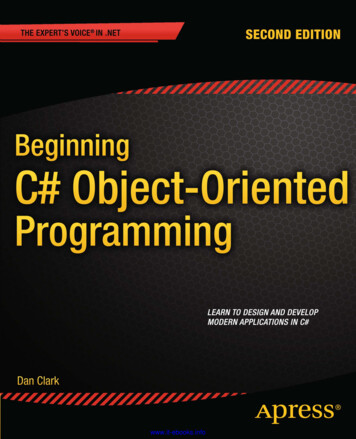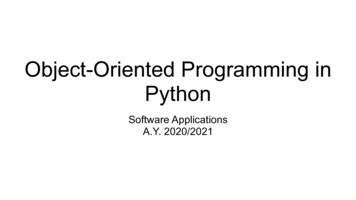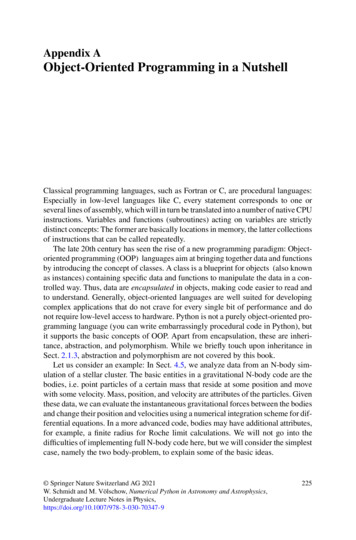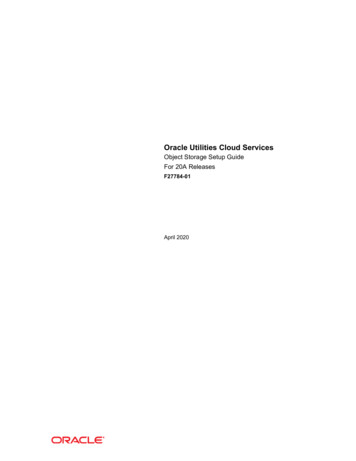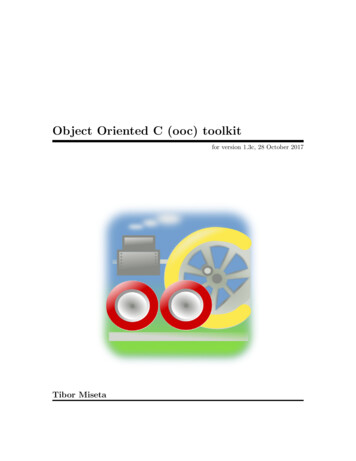
Transcription
Object Oriented C (ooc) toolkitfor version 1.3c, 28 October 2017Tibor Miseta
This manual is for Object Oriented C (ooc) toolkit (version 1.3c, 28 October 2017), whichis a lightweight collection of tools for Object Oriented programming approach in ANSI-C.Copyright c Tibor Miseta 2008-2011 Free Software Foundation, Inc.Permission is granted to copy, distribute and/or modify this document under theterms of the GNU Free Documentation License, Version 1.2 or any later versionpublished by the Free Software Foundation; with no Invariant Sections, noFront-Cover Texts, and no Back-Cover Texts. A copy of the license is includedin the section entitled “GNU Free Documentation License”.(a) The FSF’s Back-Cover Text is: “You have the freedom to copy and modifythis GNU manual. Buying copies from the FSF supports it in developing GNUand promoting software freedom.”
iTable of Contents1Introduction . . . . . . . . . . . . . . . . . . . . . . . . . . . . . . . . . . . . . 12Objects and Classes . . . . . . . . . . . . . . . . . . . . . . . . . . . . 22.12.22.32.42.5Underlying data structure . . . . . . . . . . . . . . . . . . . . . . . . . . . . . . . . . . . . . .Inheritance . . . . . . . . . . . . . . . . . . . . . . . . . . . . . . . . . . . . . . . . . . . . . . . . . . . . .Class data members . . . . . . . . . . . . . . . . . . . . . . . . . . . . . . . . . . . . . . . . . . . .Member functions . . . . . . . . . . . . . . . . . . . . . . . . . . . . . . . . . . . . . . . . . . . . . .Virtual functions . . . . . . . . . . . . . . . . . . . . . . . . . . . . . . . . . . . . . . . . . . . . . . .2.5.1 Overridden virtual functions . . . . . . . . . . . . . . . . . . . . . . . . . . . . . . .2.5.2 Calling parent’s virtual functions . . . . . . . . . . . . . . . . . . . . . . . . . .2.6 Class description table . . . . . . . . . . . . . . . . . . . . . . . . . . . . . . . . . . . . . . . . .3Exception handling . . . . . . . . . . . . . . . . . . . . . . . . . . . . . 83.13.23.33.43.53.6423344566Throwing an exception . . . . . . . . . . . . . . . . . . . . . . . . . . . . . . . . . . . . . . . . . 8Catching an exception . . . . . . . . . . . . . . . . . . . . . . . . . . . . . . . . . . . . . . . . . . 8Finalize the exception handling . . . . . . . . . . . . . . . . . . . . . . . . . . . . . . . . . 9Closing the try block . . . . . . . . . . . . . . . . . . . . . . . . . . . . . . . . . . . . . . . . . . 9Protecting dynamic memory blocks and objects . . . . . . . . . . . . . . . . . 9Managed pointers . . . . . . . . . . . . . . . . . . . . . . . . . . . . . . . . . . . . . . . . . . . . . 103.6.1 Managing a pointer . . . . . . . . . . . . . . . . . . . . . . . . . . . . . . . . . . . . . . 103.6.1.1 Manage a pointer: ooc manage() . . . . . . . . . . . . . . . . . . . . 113.6.1.2 Manage an Object: ooc manage object(). . . . . . . . . . . 113.6.1.3 Pass the ownership: ooc pass() . . . . . . . . . . . . . . . . . . . . . 113.6.2 Examples . . . . . . . . . . . . . . . . . . . . . . . . . . . . . . . . . . . . . . . . . . . . . . . . 113.6.2.1 Protecting temporary memory allocation. . . . . . . . . . . . . 113.6.2.2 Taking over the ownership of parameters . . . . . . . . . . . . . 12Using Classes . . . . . . . . . . . . . . . . . . . . . . . . . . . . . . . . . . 134.14.24.3Initializing the class . . . . . . . . . . . . . . . . . . . . . . . . . . . . . . . . . . . . . . . . . . .Creating an object of a class . . . . . . . . . . . . . . . . . . . . . . . . . . . . . . . . . .Deleting an object . . . . . . . . . . . . . . . . . . . . . . . . . . . . . . . . . . . . . . . . . . . .4.3.1 Deleting an object directly . . . . . . . . . . . . . . . . . . . . . . . . . . . . . . .4.3.2 Deleting object via pointer . . . . . . . . . . . . . . . . . . . . . . . . . . . . . . .4.4 Accessing class members . . . . . . . . . . . . . . . . . . . . . . . . . . . . . . . . . . . . . .4.5 Finalizing a class . . . . . . . . . . . . . . . . . . . . . . . . . . . . . . . . . . . . . . . . . . . . . .4.6 Dynamic type checking . . . . . . . . . . . . . . . . . . . . . . . . . . . . . . . . . . . . . . . .1313141414141515
ii5Implementing Classes . . . . . . . . . . . . . . . . . . . . . . . . . 175.15.25.35.45.5Naming conventions . . . . . . . . . . . . . . . . . . . . . . . . . . . . . . . . . . . . . . . . . . .Source files. . . . . . . . . . . . . . . . . . . . . . . . . . . . . . . . . . . . . . . . . . . . . . . . . . . .Class user header file . . . . . . . . . . . . . . . . . . . . . . . . . . . . . . . . . . . . . . . . . .Class implementation header file . . . . . . . . . . . . . . . . . . . . . . . . . . . . . .Class implementation file . . . . . . . . . . . . . . . . . . . . . . . . . . . . . . . . . . . . . .5.5.1 Class allocation . . . . . . . . . . . . . . . . . . . . . . . . . . . . . . . . . . . . . . . . . .5.5.2 Class initialization . . . . . . . . . . . . . . . . . . . . . . . . . . . . . . . . . . . . . . .5.5.3 Class finalization . . . . . . . . . . . . . . . . . . . . . . . . . . . . . . . . . . . . . . . . .5.5.4 Constructor definition . . . . . . . . . . . . . . . . . . . . . . . . . . . . . . . . . . . .5.5.5 Copy constructor definition . . . . . . . . . . . . . . . . . . . . . . . . . . . . . . .5.5.5.1 Using the default copy constructor . . . . . . . . . . . . . . . . . . .5.5.5.2 Creating your own copy constructor . . . . . . . . . . . . . . . . .5.5.5.3 Disabling the copy constructor . . . . . . . . . . . . . . . . . . . . . . .5.5.6 Destructor definition . . . . . . . . . . . . . . . . . . . . . . . . . . . . . . . . . . . . .5.5.7 Implementing class methods . . . . . . . . . . . . . . . . . . . . . . . . . . . . . .5.5.7.1 Non-virtual methods . . . . . . . . . . . . . . . . . . . . . . . . . . . . . . . .5.5.7.2 Virtual methods . . . . . . . . . . . . . . . . . . . . . . . . . . . . . . . . . . . . .5.6 Classes that have other classes . . . . . . . . . . . . . . . . . . . . . . . . . . . . . . . .6Interfaces and multiple inheritance . . . . . . . . . . 266.1What is an interface? . . . . . . . . . . . . . . . . . . . . . . . . . . . . . . . . . . . . . . . . .6.1.1 Interfaces and inheritance . . . . . . . . . . . . . . . . . . . . . . . . . . . . . . . .6.1.2 Creating an interface . . . . . . . . . . . . . . . . . . . . . . . . . . . . . . . . . . . . .6.1.3 Implementing an interface . . . . . . . . . . . . . . . . . . . . . . . . . . . . . . . .6.1.3.1 Adding the interface to the virtual table . . . . . . . . . . . . .6.1.3.2 Implementing the interafce methods . . . . . . . . . . . . . . . . .6.1.3.3 Initializing the virtual table . . . . . . . . . . . . . . . . . . . . . . . . .6.1.3.4 Registering the implemented interafces . . . . . . . . . . . . . . .6.1.3.5 Allocating the class with interfaces . . . . . . . . . . . . . . . . . .6.1.4 Using an interface . . . . . . . . . . . . . . . . . . . . . . . . . . . . . . . . . . . . . . . .6.1.4.1 If the type of the Object is known . . . . . . . . . . . . . . . . . . .6.1.4.2 If the type of the Object is unknown . . . . . . . . . . . . . . . . .6.2 Mixins . . . . . . . . . . . . . . . . . . . . . . . . . . . . . . . . . . . . . . . . . . . . . . . . . . . . . . . .6.2.1 Creating a mixin . . . . . . . . . . . . . . . . . . . . . . . . . . . . . . . . . . . . . . . . .6.2.2 Implementing a mixin by a carrier class . . . . . . . . . . . . . . . . . . .6.2.3 How mixins work?. . . . . . . . . . . . . . . . . . . . . . . . . . . . . . . . . . . . . . . 28292929292930303233Memory handling. . . . . . . . . . . . . . . . . . . . . . . . . . . . . . 357.17.27.3Memory allocation . . . . . . . . . . . . . . . . . . . . . . . . . . . . . . . . . . . . . . . . . . . . 35Freeing the allocated memory . . . . . . . . . . . . . . . . . . . . . . . . . . . . . . . . . 35Thread safety . . . . . . . . . . . . . . . . . . . . . . . . . . . . . . . . . . . . . . . . . . . . . . . . . 36
iii8Unit testing support . . . . . . . . . . . . . . . . . . . . . . . . . . 378.18.29How to create a unit test? . . . . . . . . . . . . . . . . . . . . . . . . . . . . . . . . . . . . .Writing a unit test . . . . . . . . . . . . . . . . . . . . . . . . . . . . . . . . . . . . . . . . . . . .8.2.1 Writing test methods . . . . . . . . . . . . . . . . . . . . . . . . . . . . . . . . . . . . .8.2.2 Assertions . . . . . . . . . . . . . . . . . . . . . . . . . . . . . . . . . . . . . . . . . . . . . . . .8.2.3 Messages . . . . . . . . . . . . . . . . . . . . . . . . . . . . . . . . . . . . . . . . . . . . . . . . .8.2.4 Overriding virtuals . . . . . . . . . . . . . . . . . . . . . . . . . . . . . . . . . . . . . . .8.2.5 Testing exceptions. . . . . . . . . . . . . . . . . . . . . . . . . . . . . . . . . . . . . . . .8.2.6 Memory leak test. . . . . . . . . . . . . . . . . . . . . . . . . . . . . . . . . . . . . . . . .8.2.7 Unit testing techniques: . . . . . . . . . . . . . . . . . . . . . . . . . . . . . . . . . .8.2.7.1 Inherited test cases . . . . . . . . . . . . . . . . . . . . . . . . . . . . . . . . . .8.2.7.2 Using fake objects . . . . . . . . . . . . . . . . . . . . . . . . . . . . . . . . . . .8.2.7.3 Using mock objects . . . . . . . . . . . . . . . . . . . . . . . . . . . . . . . . . .8.2.8 Dependency lookup . . . . . . . . . . . . . . . . . . . . . . . . . . . . . . . . . . . . . .37383838394041414242424242Class manipulation tool . . . . . . . . . . . . . . . . . . . . . . . 44Appendix A GNU Free Documentation License. . . . . . . . . . . . . . . . . . . . . . . . . . . . . . . . . . . . . . . . . . . . . . . . 46Table of Figures . . . . . . . . . . . . . . . . . . . . . . . . . . . . . . . . . . . 52Index . . . . . . . . . . . . . . . . . . . . . . . . . . . . . . . . . . . . . . . . . . . . . . . 53
Chapter 1: Introduction11 IntroductionObject Oriented C toolkit, or shortly ooc has been created with the intention to enable towrite object oriented code easily using standard ANSI-C, with all the possible type checks.It is very important being ANSI-C compliant, because the main goal was the portabilityeven for systems that lack a C compiler.The other goal was keeping it lightweight, being able to port it onto small computers aswell, like embedded systems. The implementation has a C like approach, using classes,objects, and exceptions. The ooc also incorporates single inheritance and with the help ofinterfaces and mixins a kind of multiple inheritance.There are many similar kits out there, but I found most of them either too complicatedfor writing a fully controllable, really portable code, or inconvenient to use it for writingreadable programs. So I have started from scratch.The ooc toolkit comes with some container classes, a unit testing helper class and a toolthat let’s you generate classes from several templates easily.In this manual I will cover only issues related to the implementation and use of ooc, Iassume that the reader is familiar with the Object Oriented Programming and has a goodknowledge about C and C and their most common internal implementation.More detailed information on the use of ooc can be found in the ooc API documentation.
Chapter 2: Objects and Classes22 Objects and ClassesClass is the type of an Object instance. It specifies its data and function members andmethods. We use the same terminology as in C here.Before an Object could be used, it must be instantiated.The Classes and Objects are located in the memory, as the following section describes.2.1 Underlying data structureFigure 2.1: Underlying data structureThe Class description table and the Virtual table are allocated statically in compilationtime while the Object instances are allocated dynamically on the heap in run time. TheClass allocation table is fully initialized at compilation time, while the Virtual Table must
Chapter 2: Objects and Classes3be initialized in run time before the Class is used. Due to this limitation it is not possibleallocating Objects statically on the heap.There is always a Virtual table, even if the class does not have a virtual function. Inthis case it is just a single pointer to the Class description table.2.2 InheritanceIn ooc single inheritance is supported. The physical implementation of inheritance is embedding the parent class members into the beginning of the instantiated object.Real multiple inheritance is not supported because of considering run time effectivenesson slower computers; plus trying to avoid complex inheritance problems that may occur incase of multiple inheritance, and a good solution for them would require more support fromthe compiler.However since version 1.3 ooc supports the use of interfaces and mixins providing a kindof multiple inheritance.In every class definition macros we use two parameters: First parameter is the name of the class, while the Second parameter is the name of the parent class.If a class is a base class (has no parent class), we shall mark it as it parent class wasBase. Therefore Base is a reserved class name in ooc!DeclareClass( String, Base );/* String is a Base class */DeclareClass( Utf8, String );/* Utf8 is a class inherited from String */2.3 Class data membersClass definitions are basically nested struct definitions. That means that you can accessdata members via their names, as they were accessed as struct members. There is animportant rule, that accessing the parent class’s data members requires a prefix with theparent class’s name before the data member name. This is because the standard ANSI Cdoes not allow the use of unnamed struct, and I wanted to be ANSI compliant for betterportability.ClassMembers( String, Base )char *intcstr;length;EndOfClassMembers;ClassMembers( Utf8, String )
Chapter 2: Objects and Classesint4num of ********** Accessing data members*/String my string;Utf8my utf8;int i;i my string- length;/* Accessing a class member */i my utf8- num of chars;/* Accessing a class member */i my utf8- String.length;/* Accessing class member inherited from the parent2.4 Member functionsA class member function is a normal C function, but there is a very important rule: thefirst function parameter of a member function is always a class instance object, and thisfirst parameter can not be omitted.voidstr upper( String ); /* Declaring a member function */voidstr upper( String self ) /* Defining a member function */{int i;assert( ooc isInstanceOf( self, String ) );for( i 0; i self- length; i )self- cstr[i] cupper( self- cstr[i] );}str upper( my string );/* Calling a member function */As a naming convention it is a good idea to start all class member function’s name withthe name of the class, or with a meaningful abbreviation.2.5 Virtual functionsVirtual functions have the same requirement: their mandatory first parameter is an objectinstance pointer.Virtual functions are implemented as static functions in the class implementation file, and
Chapter 2: Objects and Classes5the class’s virtual table holds pointers to these static functions.Virtual functions are called via their function pointers in the vtable.The vtable itself is basically a struct holding function pointers to the implemented staticfunctions. The calling via these function pointers provides us the capability for compilationtime type and parameter checking.For virtual function calls we use the macros and inline functions.For those compilers that the inline functions are not supported there is a function versionfor virtual function calls, but that is slower of course. This is the price for the better typesafety./* Defining a virtual function */Virtuals( String, Base )int (* str get tokens)( String );EndOfVirtuals;/* Calling a virtual function; from the user point of view */int len;String my string;len StringVirtual( my string )- str get tokens( my string );/* Implementing the virtual function in the class implementation file */static int virtual str get tokens( String self ){/* doing some important here with self */return result;}/* Initializing the virtual table in the class initialization handler */static void String init( ){StringVtableInstance.str get tokens} virtual str get token;2.5.1 Overridden virtual functionsOverriding the parent class’s virtual functions is very easy in the class implementation file.It can be done in the class initialization code./* Defining the virtual table */
Chapter 2: Objects and Classes6Virtuals( Utf8, String )/* In this case there are no new Virtual functions, oEndOfVirtuals;/* Implementing the virtual function in the class implementation file */static int utf8 get tokens( String self ){/* doing some important here with self */return result;}/* Overriding the parent’s virtual function pointer in the virtual table in the class istatic void Utf8 init( Class class ){Utf8VtableInstance.String.str get tokens} utf8 get token;/* In the class’s user code you can call the virtual in the same way: */len Utf8Virtual( my utf8 )- String.str get tokens( (String) my utf8 );2.5.2 Calling parent’s virtual functionsIf you would like to call the parent class’s virtual function (this may be necessary in theimplementation code when you would like to chain the new class’s virtual function to theparent’s one, you can use other macro accessing the original (non-overridden) function:static int utf8 get tokens( String self ){/* doing some important stuff here with self,then chaining to the original parent’s function: */return Utf8ParentVirtual( self )- str get tokens( self );}2.6 Class description tableThe Class description table is completely hidden from the user of the class. It is a staticstruct in the heap, created and initialized at compilation time. The identifier of the class isthe address of this class description table, so you must refer to the class with the "addressof" operator and the class name.You can allocate the class description table, the virtual table and some other helperswith a single macro:
Chapter 2: Objects and ClassesAllocateClass( String, Base );AllocateClass( Utf8, String );7
Chapter 3: Exception handling83 Exception handlingHowever the exception handling from the user’s point of view is very similar to the exceptionhandling in C , there are very significant differences that you must keep in mind! In oocthe key differences are: There is no stack unwinding! You must consider the side effects of optimizing compilers. There is an additional finally option. You must close the section with an end try statement. Every executed try must have an executed end try!Being able to use the exceptions you must include the exception.h header file, and callooc init class( Exception ); at the very beginning of your code! Because ooc uses theexceptions internally, you must always initialize the Exception class in your code beforeusing any other ooc features!3.1 Throwing an exceptionThrowing an exception is very easy with the ooc throw() instruction. The parameterof the ooc throw() is any Object. The object is "owned" by the exception handlingmechanism and will be deleted by it, so never delete it yourself, and never throw an object,that you would like to use later. In practice I recommend throwing newly created objectsof Exception class or its subclasses, like:if( error )ooc throw( str exception new( str error code ));You can use ooc rethrow() as well for passing the actual exception to the caller, butonly inside a catch() or in a catch any block.3.2 Catching an exceptionYou can catch the thrown exceptions with the catch() or catch any blocks.The catch( Class ) block catches the objects of the specified class or its subclasses.The caught object is stored in a variable called Exception exception, that is automaticallydefined and can be used only within the catch block.The catch any block catches all exceptions that were not handled by the earlier catchblocks. It is typically used for cleanup and rethrow of exception that could not be handledlocally. You can use as many cath() blocks, as many you need, plus one catch any blockas the last one. Be careful with the ordering of the catch() blocks: catching a class meanscatching all of the subclasses as well.
Chapter 3: Exception handling93.3 Finalize the exception handlingYou can notice, that there is a finally option as well, that will run in every case. It isvery important that codes in the finally block can not fail (can not throw any exception)!This section will run in every case, regardless of the existence of an exception, or if it wascaught or not. The finally block must be the last section of a try . end try block.3.4 Closing the try blockYou must close the try block sequence with an end try; statement. You don’t have touse all of the possible blocks in the try . end try block, however at least one catch orcatch any or finally block must be used. Every executed try must have an executedend try! In practice this means that you must NOT return from within the try block!(Or jump out with goto, but who does use it? :-))3.5 Protecting dynamic memory blocks and objectsUnlike C there is no stack unwinding during the exception handling! Consequently youmust pay extra attention on memory handling in your routines: make sure that everytemporarily allocated memory block is freed in case of an exception rises in the routine orin routines called. The simplest solution is a try . finally . end try block. It isrelatively not computationally expensive, and is effective. For example the code below willlead to memory leak if there would arise an exception:void my func( void ){char * mem;mem ooc malloc( 1000 );do a risky call(); /* If this code throws an exception then *//* the mem will never be freed, causing a */ooc free( mem );/* memory leak!*/}The correct solution is protecting the sensible variables like follows:void my func( void ){char * volatile mem NULL;try {mem ooc malloc( 1000 );do a risky call();}finally {ooc free( mem );}end try;}
Chapter 3: Exception handling10Listen to the followings in the above code: Use volatile storage class specifier for those variables that change their value in thetry code section, and you would like to use this new value in any of the catch orfinally blocks, or after the end try statement! This is necessary, because the trysolution is based on setjmp/longjmp, that may change the register values, so we mustprevent optimizing compilers using registers for these variables. Forgetting settingvolatile typically brings you in a situation where the debugged code works properly,but the optimized release fails while handling exceptions. Initialize the pointer variable with NULL! This is necessary because the local variableis located on the stack, and gets a random starting value. If you forget the initialization, and the memory allocation would fail, then freeing this pointer in the finallysection would refer to an undefined memory block, and most probably would cause asegmentation fault.In most cases you want to prevent memory leak only, and do not necessarily need to getthe control in the case of an exception. For those situations there is a simpler mechanismdescribed in the next section.3.6 Managed pointersIn ooc you have an other option for preventing memory leaks in case of an exception: themanaged pointers. Using managed pointers you will not get the program control in case ofan exception, but it is guaranteed, that the memory is freed or the Object is deleted in caseof an exception. (You may consider this as analogie for std::auto ptr in C .)Using managed pointers is faster than using the try . finally . end try constructs,so it is more advisable if you do not need the program control in case of an exception.3.6.1 Managing a pointerManaging a pointer means that ooc will take care of freeing the resouce in case of anexception. You can manage a pointer with the ooc manage() macro. This macro pushesthe pointer (and the corresponding destroyer function) to the top of the managed pointersstack.If there is an exception thrown, ooc will continue the program execution at the next catchor finally statement, and takes care that all memory or Objects that are referenced by themanaged pointers pushed onto the stack, are freed or deleted respectively till that point.If there was no exception thrown, you must remove the pointer from the stack with theooc pass() macro.Because the managed pointers’ stack is a stack, you can remove the most recently pusheditem only: you must use ooc pass() always in the reverse order of using ooc manage()!Use ooc manage() / ooc manage object() and ooc pass() always as a pair in the samename scope! These macros use local variables, and the variable created by ooc manage()must be accessible by ooc pass()! Never let ooc manage() be executed more than oncewithout executing the corresponding ooc pass() before!To be ANSI-C compliant, the ooc manage() and ooc manage object() macros alwaysmust preceed any statement in the given namespace! (This is because they define a local
Chapter 3: Exception handling11variable.) In practice this means that you must open a new name scope with { if you’d liketo use the managed pointer in the middle of your code. Close this name scope only afterpassing the managed pointer. You can nest more namescopes when using multiple managedpointers. See the first example!3.6.1.1 Manage a pointer: ooc manage()Pushes a pointer onto the top of the managed pointers’ stack.ooc manage() requires two parameters: the pointer to the resource and the appropriatedestroyer function for it (typically ooc delete or ooc free).ooc manage() does not return anything.3.6.1.2 Manage an Object: ooc manage object()Manages an Object like ooc manage().This is shortcut for ooc manage( my object, (ooc destroyer) ooc delete );.3.6.1.3 Pass the ownership: ooc pass()Removes the most recently pushed pointer from the managed pointers’ stack. Always usein the reverse order of using ooc manage()!ooc pass() requires one parameter: the pointer to be removed.Please note that since the most recently pushed pointer is removed, the parameter is usedonly for verification that the push an pop orders are correct! (In release versions thisverification is skipped for gaining some speed.)ooc pass() returns the pointer itself.The name is coming from passing the ownership of the pointer to an other object or function.3.6.2 Examples3.6.2.1 Protecting temporary memory allocationIn the previous section we used try . finally . end try to prevent memory leak fora temporary memory allocation. The same with managed pointer:void my func( void ){char * mem;mem ooc malloc( 1000 );{ooc manage( mem, ooc free );do a risky call();ooc free( ooc pass( mem ) );}}Simplier, faster.
Chapter 3: Exception handling123.6.2.2 Taking over the ownership of parametersvoid foo add bar( Foo self, Bar bar ){ooc manage( bar, (ooc destroyer) ooc delete );do a risky call();/* pass the ownership of bar to selfself- bar ooc pass( bar );*/}Foo foo;foo foo new();foo add bar( foo, bar new() ); /* this code is safe! */If you we’re not using managed pointers for taking over the ownership of the parameterthen the parameter object would be leaked in case of an exception in the do a riskycall() method.
Chapter 4: Using Classes134 Using Classes4.1 Initializing the classBefore you can use your class, you must initialize it! Initializing a class will automaticallyinitialize its superclasses, so if you have inherited your class from occ system classes (likeRefCounted), you do not have to initialize them separately. However, because ooc uses theException class internally, you must initialize it before calling any ooc function.intmain( int argc, char * argv[] ){ooc init class( Exception );ooc init class( MyClass );do my program();return 0;}4.2 Creating an object of a classCreating an object is easy with the ooc new marco, or with the equivalent ooc newclassptr function.The ooc new( classname, void * param ) macro converts the Class name to the appropriate class description table address, and calls the ooc new classptr function. Useooc new when you create your class from a statically known class (you know the class name).The second parameter is passed to the class constructor code without any modification orcheck. You can parameterize your constructor this way, it is advisable passing a variable orstruct pointer here. The variable or the struct must exist until the constructor returns!The ooc new classptr( Class class ptr, void * param ) function creates an objectof the class pointed by the first parameter. Use this function when you know only the classdescription table’s address! This is very rare situation, and I guess it is mainly useful insidethe ooc code. The second parameter is passed to the class constructor code without anymodification or check.The above methods return objects of Object type.Although using the ooc new macro for object creation is easy, it is advisable to definea parameterized . new() function for each class, because that way you can control theparameter checking, as well as the automatic conversion of return type (ooc new returnsObject that you must cast to the desired type).
Chapter 4: Using Classes14String str new( char * initial ){return ooc new( String, initial );}4.3 Deleting an objectThe created objects must be deleted with one of the deletion functions. They must not befreed with the standard memory handling functions, like free or ooc free!4.3.1 Deleting an object directlyDeleting an object can be done with the ooc delete( Object ) function. It calls the classdestructors on the object, and frees the allocated memory. Any pointer to this objectwill not be usable after deleting the object! Use this way an object destruction when youwould like to destroy objects that you did allocate temporarily in your C functions as localvariables.4.3.2 Deleting object via pointerIn many cases it is important to mark that the
Chapter 1: Introduction 1 1 Introduction Object Oriented C toolkit, or shortly ooc has been created with the intention to enable to write object oriented code easily using standard ANSI-C, with all the possible type checks.
